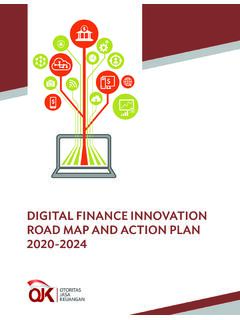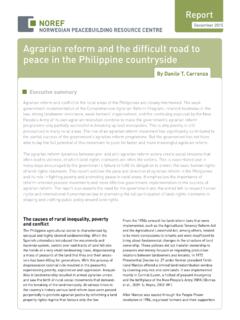Transcription of India - On the Cusp of a Logistics Revolution
1 India - On the Cusp of a Logistics RevolutionJanuary 20181. Introduction 062. Challenges of the Indian Logistics sector 083. Integrated end-to-end Logistics 124. Forward movement towards the fourth industrial Revolution - Adoption of digital technologies 165. Strategy to Implementation A cohesive national Logistics policy / blueprint 20 ContentsIndia - On the Cusp of a Logistics Revolution03 About ASSOCHAMASSOCHAM is the oldest Apex Chamber established in 1920. ASSOCHAM initiated its endeavour of value creation for Indian industry since its inception. It spearheads the interest of more than 400 Chambers and Trade Associations under its fold, catering directly and indirectly over 4,00,000 members across the country. ASSOCHAM is well respected for its balanced and studied approach to matters pertaining to development of trade and industry and promotion of government-industry inter-linkages.
2 ASSOCHAM plays an important role in the shaping of India s Economic, Trade, Fiscal and Social policies. ASSOCHAM s National Councils (nearly 90) represent different segments of service and manufacturing industry taxation, insurance, finance, capital markets, international trade, energy, oil & gas, mining, coal, steel, aviation, Defence, automotive, agriculture, manufacturing, shipping and Logistics , road transport, housing, environment ads safety, CSR, HR and labour affairs, legal cell, information technology, International trade etc. The National Councils serve as the backbone for Chamber s effective functioning and help identify industry concerns and influence Government (Central and State) policies. ASSOCHAM thus provides networking opportunities for its constituent members and also makes special efforts to emphasize its member s viewpoints in policy formulations.
3 ASSOCHAM has emerged as the fountainhead of knowledge for the Indian industry, which is all set to redefine the dynamics of growth and development in the technology-driven cyber age of the knowledge-based economy . ASSOCHAM Corporate Office5 Sardar Patel Marg, Chanakyapuri, New DelhiTel: +91 - 11- 46550500 Fax: +91- 11- 23017008/09 Website: - On the Cusp of a Logistics Revolution04 Foreword Peeyush NaiduPartnerDeloitte Touche Tohmatsu India LLP Tel: 0124-6792401 The Indian Government s policy initiatives like Make in India and the nation-wide implementation of a uniform indirect tax system hold promise for an efficient, integrated and buoyant economy. Logistics industry would be a critical enabler and facilitator on this journey towards achieving the envisioned growth potential - with better stakeholder coordination, increased infrastructure investment and improved operational efficiency.
4 ASSOCHAM recently organized a conference titled India on the cusp of a Logistics Revolution in which diverse stakeholders groups including policymakers, transport and terminal infrastructure service providers, and Logistics service providers (LSPs) deliberated on issues impacting the sector. Discussion centered around three themes, namely the primacy of end-to-end Logistics integration, role and impact of digitization and the contours and efficacy of a comprehensive National Logistics post-conference thought paper explores each of these themes. It discusses how inadequate infrastructure, lack of digital adoption, insufficiently skilled labour, low performance standards and regulatory hurdles continue to affect the performance of the Logistics industry. The paper focuses on how integrated end-to-end Logistics network with required infrastructure facilities, and a digital and services platform can lead to improved efficiency.
5 The paper also highlights that how globalization and digital evolution viz. new technologies such as Cloud Computing, Block Chain Technology, Internet of Things, are being used by the logistic sector to streamline processes and ensure a smoother interface. The paper finally suggests the possible contours of a National Logistics Policy that the Government may consider and was our privilege to support ASSOCHAM as their post-conference knowledge partner on this important topic. We hope that this paper leads to a discourse among policymakers and industry players on revitalizing India s Logistics industry to enhance its contribution to the economic growth potential of the - On the Cusp of a Logistics Revolution051. IntroductionThe performance of Logistics sector in the economic development of India has never been more compelling. A robust Logistics sector can go a long way in boosting India s quest for being a manufacturing giant given that several initiatives like Make in India have been launched by the government.
6 Increasingly, companies across the globe are looking at the world as both a unified production base and a market that a competitive Logistics sector can successfully tap into. The industry has seen rapid growth in the last few years due to increased planned outlay of the government, improved infrastructure facilities and greater access to global markets. However, our services have not adequately capitalized on the opportunity in the global market as multiple challenges continue to mire t he s e c tor. The effort in the years ahead is to build a more robust Logistics network in the country. With better infrastructure planning, increased coordination among stakeholders and improved operational efficiencies, India aims to unlock the potential of the sector needed to fuel economic growth. A conference titled India On the Cusp of a Logistics Revolution was organised by ASSOCHAM in July 2017 to discuss and deliberate various aspects pertaining to the sector.
7 Stakeholders from across the industry, which included policymakers, modal infrastructure service providers, terminal infrastructure providers and Logistics service providers (LSPs), attended the conference. India - On the Cusp of a Logistics Revolution06 The conference aimed to: a) identify key challenges that inhibit growth of the Logistics sector, b) deliberate potential solutions such as integrated end-to-end Logistics and adoption of digital technologies, and c) discuss /examine possibility of implementing a cohesive national Logistics paper is divided into four main sections comprising session summaries and insights into the key themes of the conference. The paper begins with a discussion of challenges that ail the Logistics sector in the country. The following sections discuss possible ways to address these issues, of which the integration of the Logistics value chain and adoption of digital technologies are two chief components, sewn together within an overarching framework of a National Logistics Policy.
8 The need for a National Logistics Policy in India Infrastructure creation to move from being unstructured/arbitrary to a planned model at Government policy level. Need for a National Logistics Policy with guidelines to maximize use of existing infrastructure/assets, while creating a blueprint for future growth/demand, both at Govt. and private investment level. Research reports are available with various ministries, but lack cohesive action due to multiple Ministries and agencies involved Is there need for a Logistics Infrastructure Development panel with investment and regulatory powers? Transitioning towards an integrated end-to-end Logistics Should we first create Demand before developing modes of Supply? Need for an integrated well-knit network of Logistics enablers-rail, road, air and waterways. Need to ensure cargo movement in the right mode, for optimum use of existing infrastructure.
9 Dangers of a skewed Logistics framework with catastrophic effect on the digital technologies in Logistics chain Are traditional Logistics companies ready for a digitally connected and integrated supply chain? Is India ready to implement digitalization of the Logistics chain involving the cloud, internet, 3D printing, virtual realities, and most important, skilled workforce. How some companies are using technology to improve their supply chain 1 Theme 2 Theme 3 Highlights from the conferenceIndia - On the Cusp of a Logistics Revolution072. Challenges of the Indian Logistics sectorWith globalization, Logistics is expected to play an increasing role in driving the Indian economy. In 2016, India was ranked 35th in The World Bank LPI Index that ranks countries based on their Logistics performance moving up from 54th in 2014. While this is reflective of improvement in the sector, multiple challenges of infrastructural deficiency, lack of integration amongst stakeholders, lack of skilled manpower and slow adoption of technology continue to weigh it down.
10 Infrastructure - It is one of the biggest hurdles that has cramped growth of the Logistics sector. It gets reflected in inadequate and low-quality modal and terminal transport infrastructure, suboptimal modal mix, inefficient and ill-designed storage facilities for cargo and containers and inefficient operational and maintenance protocols, and poor adoption/adaptation of technology. This leads to high and inconsistent cargo transit time, inefficient use of resources and poor fleet management. The selection of the mode of transport, or even storage and terminal handling protocols are rarely linked to cargo characteristics (distance of travel, parcel size, density, etc.). As a result, there is overuse of high-cost modes like road at the expense of cost-effective and sustainable modes like inland waterways and railways. The continuing and prolonged suboptimal system, which erroneously appears India - On the Cusp of a Logistics Revolution08to be in equilibrium, needs to be changed.

















